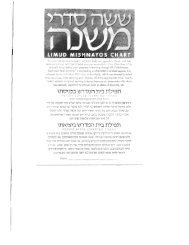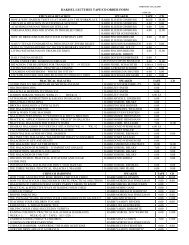Household Guide to Shatnez - Hakhel.Info
Household Guide to Shatnez - Hakhel.Info
Household Guide to Shatnez - Hakhel.Info
You also want an ePaper? Increase the reach of your titles
YUMPU automatically turns print PDFs into web optimized ePapers that Google loves.
<strong>Guide</strong> ‘10To A ShaTnez-Free HomeINTRODUCTIONThis <strong>Info</strong>rmation is current only at the time of publicationFrequently Asked Questions: What types of clothing need shatnez testing? Garments from which countries should I avoid? Can I tell from the label if a garment is non-shatnez?When shopping for clothing, the Jewish consumer wants<strong>to</strong> be sure that his purchase is shatnez –free.Unfortunately, the information generally available <strong>to</strong> theconsumer is very limited and occasionally misleading.Outlined below are the sources of this information andan explanation of their inadequacies.Content LabelsBy Federal law, all garments are required <strong>to</strong> have a labellisting the content of the fabric. However, only the mainshell fabric of the garment is included in thisrequirement. The content of linings, reinforcements, andinternal components of the garment are not listed on thelabel. In addition, any fiber making up less than 5% ofthe content is not identified by name, but listed as “otherfibers”. Even decorations and embroidery on the outsideof the garment are only referred <strong>to</strong> as “exclusive ofornamentation”.Besides the deficiencies in the labeling law, the problemis further compounded by the government’s laxness inenforcing these laws. Many companies, knowing thatthey have nothing <strong>to</strong> fear from an enforcement agency,do not bother <strong>to</strong> accurately identify the fibers used intheir products, and may even deliberately misrepresenttheir content in order <strong>to</strong> boost sales. Consumers shouldmake a habit of reading the content label in order <strong>to</strong>avoid obvious shatnez.Retailer’s claimsA s<strong>to</strong>reowner or salesperson cannot possibly be familiarwith all of the components and fabrics incorporated inthe garments they sell. Even the fac<strong>to</strong>ries thatmanufacture clothing are often unaware of, and are notrequired <strong>to</strong> know, the content of internal reinforcementsused in their products. Because of this lack ofinformation, even a shomer shabbos retailer ormanufacturer cannot be relied upon <strong>to</strong> claim that hismerchandise is shatnez-free. This applies even thoughthe clothing was manufactured especially for him, andeven if he was present at the fac<strong>to</strong>ry during production.In addition, many retailers will falsely testify that aparticular garment was tested and found non-shatnez. Allgarments pre-tested by an authorized shatnez labora<strong>to</strong>rywill carry an official label.Tailors and unqualified testersThere are some tailors and other people who claim <strong>to</strong>know shatnez testing. While they may be familiar withthe basic elements of testing, they have not been trainedin the complexities of garment construction andidentification, and they do not keep up-<strong>to</strong>-date with theconstant stream of new developments in the field. Only acertified shatnez tester, who has received extensivetraining and who is informed of the latest problems andprocedures, can be relied upon <strong>to</strong> ensure that one’sclothing is shatnez-free.Since all these sources cannot be relied on forinformation about shatnez, where can one obtain theknowledge <strong>to</strong> avoid shatnez problems? To address thisneed, the International Association of Professional<strong>Shatnez</strong> Testers and Researchers has compiled a chart ofclothing and household items, the shatnez problems theycan have, and their testing requirements. Thisinformation, presented on the following pages in chartform, is based on years of experience and input from ournetwork of expert testers all over the world. Theinformation contained in this guide is current at the timeof publication. Changes are constantly occurring and it isimportant <strong>to</strong> keep up <strong>to</strong> date. Updates via email willinform you of all the latest changes and new alerts. Youcan also contact your local shatnez tester for advice onthese issues. To receive the emails, contact:shatnezhedqtrs@yeshivanet.com
ITEM DETAILS REQUIRES TESTING? COMMENTSAlterations/Tailoring See “Tailoring”Army/Navy SurplusBandagesBaseball glovesBed linensBekeshesBelts, leatherBelts,FabricBlankets/QuiltsBlouses/dresses/jumpers(including children’s)Boots (men’s, women’s andchildren’s)Military-type garments, especiallyEuropean, including coats, hats,uniforms, etc, are likely <strong>to</strong> containextensive shatnez due <strong>to</strong> their durableconstruction.May contain felt pads of recycledmaterial. However some are filled withpure virgin synthetic fibers.Testing is required.Do not require testing.Halachic opinions on thiscomplex issue vary widely.Do not require testing.Even though the external fabric is usually silk or synthetic the internalconstruction could contain wool. Linen has also been found on occasion.Testing is recommended.Do not require testingIf has a linen-look,reprocessed look, or if it listswool or “other fibers”, itshould be tested.Blankets made of wool or“mixed fibers” or has anappliqué, should be tested.Down and polyester-filledquilts do not need testing.All wool or wool blend, linen or linen blend, linen-look fabric, lists “otherfibers,” or has an appliqué, trimmings etc requires testing.Cot<strong>to</strong>ns and poly-cot<strong>to</strong>ns do not need testing. Rayons and silks that have alinen-look require testing.Felt or fleece boot linings may be wool, Boots require testing if theywhile stitching may be linen.are lined with wool or fleece.When purchasing theseitems, which are usuallynon-returnable, bear inmind that the shatnez maybe so extensive that thegarment cannot berepaired.Tish bekeshes that do nothave a lining do not need<strong>to</strong> be tested.Hand-made blankets, suchas those made in India orpurchased in an Arabshuq, should be tested.In the case of a snap-onlinen collar on a wooldress, consult your Rov.Removable boot linersmay contain recycledmaterials.Caps & BeretsCapes- See sweatersCardigans – see sweatersCarpet/RugsCaps may contain shatnez in the fabricor lining.Carpet manufactures are producingcarpets and area rugs made of wool andlinen.Have it tested when fabric iswool, tweed, linen or linenlook.Non-woollen carpets do notrequire testing.There are many halachospertaining <strong>to</strong> the use of ashatnez carpet.Chairs – see couchesHouse calls are available atmost shatnez labora<strong>to</strong>ries forthose who wish <strong>to</strong> have theircarpets tested.Generally, one may not becovered by it nor <strong>to</strong>uch itwith their bare skin (lyingon it or walking barefoot).2
ITEM DETAILS REQUIRES TESTING? COMMENTSCoats (men’s, women’s andchildren’s)Down coats, anoraks, and parkas do notrequire testing if lining is polyester ordown-filled.Windbreakers, Shearlings do not requiretesting.Wool coats require testing.Raincoats - SeeRaincoatsCoats-FurCostumesCouches, sofas and chairsChildren’s coat manufactures usereprocessed material in shell fabrics,linings and internal components.May be stitched, lined, or padded withwool and/or linen.Homemade costumes are often made ofmany fabrics and can contain shatnez.Military uniforms often contain shatnez.See “Army/Navy Surplus.”Costume rentals [including Tuxedos]often contain shatnez.Upholstery fabric – is usually made ofsynthetic materials or cot<strong>to</strong>n.Stuffing – may contain reprocessedmaterial.Testing is required.All clothing bought fromconsignment shops for Purimor performances should betested.Children’s manufacturedclown and animal costumesfor example, do not needtesting.If the upholstery fabric iswool, linen or has a linen lookthe item should be tested forshatnez.Use caution when sewingcostumes forperformances, etc. Sincethe fabrics used are oftenremnants, care should betaken <strong>to</strong> ensure that theyare not shatnez.In the case of furniturefound <strong>to</strong> contain shatnez,the halacha regarding itsuse varies according <strong>to</strong>the circumstances.CurtainsCus<strong>to</strong>m-made clothingEarmuffsEmbroidery kits –Needlepoint’sMost sofas manufactured in Israel prior<strong>to</strong> 1980 contain shatnez.Any lined cus<strong>to</strong>m-made garment, suchas skirts, suits, jackets, and coats, requireextensive testing.Embroidery, crewel, and needlepointsets can contain a linen canvas. Woolyarn is also commonly used.Textured or linen-look curtainfabrics may contain linenand/or wool and should betested for shatnez.Halacha dictates thatcurtains in one’s homecannot be shatnez, sinceone may wrap oneself init. (See Yoreh Deah301:11)Smooth or plain fabrics do notrequire testing.<strong>Shatnez</strong> testers around the world constantly report cus<strong>to</strong>mmadegarments that were guaranteed non-shatnez by thetailor, yet were subsequently found <strong>to</strong> contain shatnez.Do not require testing.A needlepoint that is shatnezone should refrain fromdraping over one’s lap whilemaking it.A picture mounted in aframe, may be hung onone’s wall even if itcontains shatnez.Fabrics and trimmingsFabrics and trimmings sold at fabrics<strong>to</strong>res could be mislabelled, since theyare often transferred through manydealers (such fabrics are usually fac<strong>to</strong>rylef<strong>to</strong>vers sold through jobbers in oddlots).All fabrics, trimmings etc.used in sewing of a garmentshould be tested <strong>to</strong> ensure thatwool and linen are notcombined in the samegarment.S<strong>to</strong>res located inOrthodox Jewishneighbourhoods havebeen found <strong>to</strong> carryshatnez fabrics.3
GlovesITEM DETAILS REQUIRES TESTING? COMMENTSThe yarn used in inexpensive knit glovesmay have been constructed fromreprocessed materials and thereforecould contain threads of wool and linen.The inner lining of inexpensive workgloves can also be of reprocessedmaterial.If lining or outer fabric has alinen-look, reprocessed look,or if it lists wool or “otherfibers” or has an appliqué, itshould be tested.Impurities i.e. pieces ofbroken threads is a sign ofreprocessed material.Ski-type gloves withThinsulate linings orleather gloves that are furlined do not need testing.HandbagsHat’s, Felt [black] men’s &boy’sHat’s, Felt women’sHats, fur (men’s andwomen’s)Standard felt “black hats” areconstructed of rabbit hair, beaver fur,and in rare cases wool.Russian fur hats are commonly found <strong>to</strong>contain linen canvases and wool felts.If made from linen or wool orhas a linen look testing isrequired.No testing is needed.Do not require testing, unlessit has a pompom, piping,appliqué or embroidery.All fur hats should be tested.Items that do not requiretestingJogging suitsKnit hats - children’sChinese fur hats are commonly found <strong>to</strong>be lined with reprocessed materials.Bandages, bed linens, bow ties, cot<strong>to</strong>n and poly-cot<strong>to</strong>n shirts, doll’sclothing, earmuffs, jogging suits, knitted sport shirts, leather belts,pyjamas, all leather or vinyl sneakers, suspenders, tichels, <strong>to</strong>wels,undergarments, wigs, yarmulkes,No testing is necessary.All wool hats require testing.All other hats do not requiretesting, unless there is apompom, piping or appliqué.Knitting yarn May contain wool and linen. Multi-coloured or linen-lookyarns should be tested.Linen garmentsMaterial - see FabricMattressesStuffing – may contain reprocessedmaterial.Exclusive mattresses have been found<strong>to</strong> contain wool and linenRequire testingStandard mattresses do notrequire testing.Mittens . Do not require testing, unlessthere is a pompom, piping orappliqué.Pants – see TrousersPillows, bedPillows, throwPajamasEmbroidered throw pillows may havewool embroidery on a linen fabric.Inexpensive pillows maybe stuffed withrecycled material, which may includewool and linen.Do not require testing.Testing is required.Do not require testing.Content labelling onknitting yarn is usuallyaccurate.Pillows containingshatnez may not be used.4
ITEM DETAILS REQUIRES TESTING? COMMENTSPotholders & Oven mitts Oven mitts and potholders are ofteninsulated or quilted with reprocessedmaterials that can contain shatnez (i.e.,threads and scraps of wool and linen).Oven mitts and potholders made forkosher kitchens, marked “Milk”,“Meat” etc., have been found insulatedwith reprocessed material. The halachaclearly states that potholders andgloves, which serve <strong>to</strong> protect one’shands, may not be shatnez. (YorehDeah 301:12)When purchasing oven mitts,the consumer can readilydetermine if there is a shatnezconcern. The insulationmaterial is usually exposedinside the mitt at the seam. Apure white or off-white stuffingis not a problem. If the stuffingmaterial is colorful, i.e.contains colored threads andfibers, it is reprocessed materialand should be avoided.QuiltsRaincoatsRobes and housecoatsRussian clothingScarvesShirts (Cot<strong>to</strong>n/Poly-cot<strong>to</strong>n)Shoes (men’s)Shoes (women’s andchildren’s)SkirtsSleeping bagsSlippersSneakersSocksSofas – see CouchesAn expensive raincoat may containshatnez in its internal construction. Inaddition, any wool-blend liner may bemade of reprocessed fabric.Polyester- and down-filledquilts do not need testing.Wool, as well as those with awoollen zip-out liner, requirestesting.Inexpensive raincoats that donot contain any wool do notneed testing.Wool or Linen robes should betested.The Russian garment industry makes extensive use of linen and wool inall types of garments. All Russian textile items must be carefully checkedfor shatnez before they are used.Solid colour wool scarves generally do not contain shatnez.Multi-coloured, knitted scarves or ones that list “other fibers” requiretesting.Consult your Rov regarding wearing a Do not require testing.linen shirt with a wool sweater etc.Do not require testing.Shoes covered with tweed,plaid or linen-look fabricrequire testing.The primary concern is the fabric. Inaddition, in European countries, linenmay be used in the lining andreinforcements.Sleeping bags are often stuffed withshredded rags and textile waste, similar<strong>to</strong> the pillows mentioned earlier.If made from linen or wool orhas a linen look testing isrequired.Testing is required.Wool or linen slippers should be tested for shatnez.Non-wool slippers may contain reprocessed padding in their soles.Do not require testing unlesscovered with tweed, plaid orlinen-look fabricSocks rarely contain shatnez, except for “Gold <strong>to</strong>e,” which approximatelytweny years ago produced a line of wool socks with linen-reinforced <strong>to</strong>es.Acrylic pile and“Thinsulate” zip-outlinings do not containshatnez.Robes labelled as purewool have been found <strong>to</strong>contain reprocessed fiber.5
ITEM DETAILS REQUIRES TESTING? COMMENTSSports gearBoxing gloves, hockey equipment, and Testing is required.other padded sports gear are usuallystuffed with recycled shredded textilewaste.Stuffed <strong>to</strong>ysTeddy bears and other stuffed <strong>to</strong>ys may contain reprocessed stuffing.If they do testing is required.Suits and jackets (men’s &Testing is required.boy’s)Suits (women’s)SuspendersSweatersSuits can contain shatnez. Even 100%synthetic and 100% silk suits maycontain wool and linen in their internalconstruction.Linen-look fabrics have been found <strong>to</strong>be mislabelled and <strong>to</strong> contain wool andlinen. Fabrics containing “other fibers”should be tested <strong>to</strong> determine theircontent.Testing is required same asmen’s suits.Do not require testing.Any sweater that its content label lists any percentage of wool, cashmere,mohair, alpaca, cashgora, angora, linen, or ramie, and those that list “otherfibers” can have shatnez in its fabric or construction. Therefore testing isrequired in all of the above.An experienced testershould do both testing andremoval of shatnez.Increasing numbers ofsuit fabrics aremislabelled, and maycontain wool and linen inthe shell fabric.TableclothsTailoring and alterationsTalleisim, cot<strong>to</strong>nTalleisim, woolThreadHowever 100% Silk, Acrylic or Cot<strong>to</strong>n sweaters do not need testing,unless they have an appliqué, pompoms, embroidery or those that areknitted with novelty yarns.Linen tablecloths withembroidery should be testedfor wool.Tailors in Europe may use linen threads. American tailors do not use linenthread. Any shoulder pad, piece of material etc added by a tailor orseamstress should be tested <strong>to</strong> determine their true content.Tablecloths of shatnezmay not be used.There are no shatnez problems. However, many “cot<strong>to</strong>n” begodim are actually made of apolyester/cot<strong>to</strong>n blend.This raises a shailoh regarding the requirement of tzitzis on such a garment, with consequent problemsof brocho leva<strong>to</strong>lo and of carrying on shabbos. Consult your Rov regarding this matter. A shatnez testercan verify the actual content of the beged.Turkishe talleisim manufactured inTunisia were found <strong>to</strong> contain linen.There have been isolated incidents anumber of years ago of fancy at<strong>to</strong>rohsfrom Israel being made with linenthread. Currently no such problemexists.Normal sewing machine thread cannotbe linen.If the Talis has a hashgochahno testing is necessary.But<strong>to</strong>n thread, upholsterythread, and thread whichappears a little thicker thannormal sewing machine threadmay be linen.Incidents have occurredof wool talleisim beingmended with linen threadsor linen patches. Allmaterials used in repairshould be tested <strong>to</strong>ascertain their content.They should be checkedso as not <strong>to</strong> sew in<strong>to</strong> awool garment.TichelsDo not require testing.6
ITEM DETAILS REQUIRES TESTING? COMMENTSTiesTie linings often contain wool. Therefore, linen ties always need testing.Polyester ties with a textured surface may also contain linen in the fabric.Silk ties are generally free of shatnez, except those from Spain, E.E.C. orItaly that could have a wool/ linen blend in their inner lining.TowelsDo not require testing.Trousers/slacksAll trousers made of wool orlinen should be tested.Any trousers that have alinen-look fabric shouldbe checked.Tuxedos Require testing. If one is unable <strong>to</strong> have atuxedo tested, a localshatnez labora<strong>to</strong>ry shouldbe consulted.UndergarmentsUpholstery fabricVests/waistcoats(men’s/women’s)WigsYarmalkasYarns – see Knitting yarnsUsually made of synthetic or cot<strong>to</strong>nmaterials.Do not require testing.If made with wool or linen, thefabric should be tested (seecouches).Require testing if made ofwool or linen.Do not require testing.Do not require testing.7
The Basic <strong>Guide</strong>lines: What Linen look fabrics look likeGarments made of “linen look” fabrics require checkingDisclosure of wool and linen is often missing on the label. Fabric dealers are also unaware oftrue fiber content. Therefore, linen-look fabrics may contain wool and linen and be intrinsically<strong>Shatnez</strong> even if no wool and linen is listed in its content label.Linen-look fabrics can be recognized, by having one of the following characteristics:1) Balls (I.E. Slubs) or streaks throughout the fabric8
2) Yarns of uneven thickness9
Tweed, textured and multi-colored fabrics may contain wool and linen and beintrinsically <strong>Shatnez</strong> even if no wool and linen is listed in its content label1) Tweed and textured fabrics2) Multi-colored fabrics10
Reprocessed fabrics may contain wool and linen and be intrinsically<strong>Shatnez</strong> even if no wool and linen is listed in its content labelThe opinions of the poskim vary regarding the use of reprocessed garments that have alreadybeen purchased. However, most rabbonim agree that it is preferable <strong>to</strong> avoid purchasing itemscontaining reprocessed fabrics.The term “other fibers” on content labels usually indicates the presence of reprocessed fiber.Testing of a reprocessed fabric will occasionally reveal wool and linen, which would make thegarment shatnez.In addition, it is recommended <strong>to</strong> repair items containing reprocessed components when this doesnot involve great expense (e.g. shoulder pads).Shoulder pad filled with Reprocessed materialPillow filled with Reprocessed materialGloves padded with Reprocessed materialSlipper filled with Reprocessed material11







